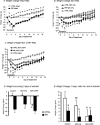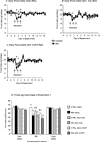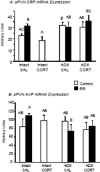The importance of corticosterone in mediating restraint-induced weight loss in rats
- PMID: 21092743
- PMCID: PMC3010503
- DOI: 10.1016/j.physbeh.2010.11.014
The importance of corticosterone in mediating restraint-induced weight loss in rats
Abstract
I. J. Scherer, P. V. Holmes, R. B.S. Harris. The importance of corticosterone in mediating restraint-induced weight loss in rats. PHYSIOL BEHAV 00 (0) 000-000, 2010. Rats restrained for 3 h/day for 3d ays (RR) lose weight and do not return to the weight of non-restrained controls once restraint has ended. This study tested the importance of restraint-induced corticosterone release in mediating the change in body weight by injecting ADX rats with 2.0mg corticosterone/kg before each restraint to replicate the restraint-induced surge in circulating corticosterone. Restrained adrenalectomized (ADX) rats injected with corticosterone had the same initial weight loss as intact restrained rats, whereas corticosterone injection in non-restrained ADX rats and restraint of ADX rats injected with saline each produced only half as much initial weight loss. Sustained weight loss, measured for 14 days after the end of RR, was the same for restrained intact rats and restrained ADX rats injected with corticosterone whereas restrained ADX rats injected with saline achieved the same weight gain as their controls. Corticosterone injections had no effect on weight gain of non-restrained intact rats. In situ hybridization showed that corticotropin releasing factor (CRF) mRNA expression in the paraventricular nucleus of the hypothalamus (PVN) was increased by the same degree in ADX rats and restrained intact rats and was not modified by corticosterone injections. There was no significant effect of restraint, ADX or corticosterone injection on PVN arginine vasopressin (AVP) mRNA expression. These data indicate that a surge in corticosterone causes sustained weight loss in ADX rats through a mechanism that can be compensated for in intact rats and is independent of changes in PVN CRF or AVP mRNA expression.
Copyright © 2010 Elsevier Inc. All rights reserved.
Figures






Similar articles
-
Independent and overlapping effects of corticosterone and testosterone on corticotropin-releasing hormone and arginine vasopressin mRNA expression in the paraventricular nucleus of the hypothalamus and stress-induced adrenocorticotropic hormone release.J Neurosci. 1999 Aug 1;19(15):6684-93. doi: 10.1523/JNEUROSCI.19-15-06684.1999. J Neurosci. 1999. PMID: 10414997 Free PMC article.
-
Immunotargeted lesions of paraventricular CRF and AVP neurons in developing rats reveal the pattern of maturation of these systems and their functional importance.J Neuroendocrinol. 1997 Jan;9(1):25-41. doi: 10.1046/j.1365-2826.1997.00544.x. J Neuroendocrinol. 1997. PMID: 9023736
-
Evidence that elevated plasma corticosterone levels are the cause of reduced hypothalamic corticotrophin-releasing hormone gene expression in diabetes.Regul Pept. 1997 Oct 31;72(2-3):105-12. doi: 10.1016/s0167-0115(97)01043-4. Regul Pept. 1997. PMID: 9652969
-
Differential glucocorticoid effects on stress-induced gene expression in the paraventricular nucleus of the hypothalamus and ACTH secretion in the rat.Stress. 2009 Sep;12(5):400-11. doi: 10.1080/10253890802530730. Stress. 2009. PMID: 19065454 Free PMC article.
-
Increased expression of corticotropin-releasing hormone and vasopressin messenger ribonucleic acid (mRNA) in the hypothalamic paraventricular nucleus during repeated stress: association with reduction in glucocorticoid receptor mRNA levels.Endocrinology. 1995 Aug;136(8):3299-309. doi: 10.1210/endo.136.8.7628364. Endocrinology. 1995. PMID: 7628364
Cited by
-
Resveratrol Ameliorates Testicular Histopathology of Mice Exposed to Restraint Stress.Animals (Basel). 2019 Sep 29;9(10):743. doi: 10.3390/ani9100743. Animals (Basel). 2019. PMID: 31569470 Free PMC article.
-
Changes of testicular phosphorylated proteins in response to restraint stress in male rats.J Zhejiang Univ Sci B. 2016 Jan;17(1):21-9. doi: 10.1631/jzus.B1500174. J Zhejiang Univ Sci B. 2016. PMID: 26739523 Free PMC article.
-
Chronic restraint stress impairs voluntary wheel running but has no effect on food-motivated behavior in mice.Brain Behav Immun. 2023 Jan;107:319-329. doi: 10.1016/j.bbi.2022.10.017. Epub 2022 Oct 29. Brain Behav Immun. 2023. PMID: 36349643 Free PMC article.
-
Pharmacological manipulation of glucocorticoid receptors differentially affects cocaine self-administration in environmentally enriched and isolated rats.Behav Brain Res. 2015 Apr 15;283:196-202. doi: 10.1016/j.bbr.2015.01.049. Epub 2015 Feb 2. Behav Brain Res. 2015. PMID: 25655510 Free PMC article.
-
Prenatal two-hit stress affects maternal and offspring pregnancy outcomes and uterine gene expression in rats: match or mismatch?Biol Reprod. 2019 Jan 1;100(1):195-207. doi: 10.1093/biolre/ioy166. Biol Reprod. 2019. PMID: 30084951 Free PMC article.
References
-
- Harris RB, Palmondon J, Leshin S, Flatt WP, Richard D. Chronic disruption of body weight but not of stress peptides or receptors in rats exposed to repeated restraint stress. Horm Behav. 2006;49:615–625. - PubMed
-
- Harris RB, Martin RJ. Recovery of body weight from below “set point” in mature female rats. J Nutr. 1984;114:1143–1150. - PubMed
-
- Harris RB, Kasser TR, Martin RJ. Dynamics of recovery of body composition after overfeeding, food restriction or starvation of mature female rats. J Nutr. 1986;116:2536–2546. - PubMed
-
- Meerlo P, De Boer SF, Koolhaas JM, Daan S, Van den Hoofdakker RH. Changes in daily rhythms of body temperature and activity after a single social defeat in rats. Physiol Behav. 1996;59:735–739. - PubMed
-
- Valles A, Marti O, Garcia A, Armario A. Single exposure to stressors causes long-lasting, stress-dependent reduction of food intake in rats. Am J Physiol Regul Integr Comp Physiol. 2000;279:R1138–1144. - PubMed
Publication types
MeSH terms
Substances
Grants and funding
LinkOut - more resources
Full Text Sources
Medical
Miscellaneous

